| |
The 'Profile' Portrait - Emily or Anne?
|
|

The 'Profile Portrait' at the National Portrait Gallery.
The 'Profile Portrait' (NPG 1724) at the NPG is identified as Emily Bronte and
the reasons for this are given in the catalogue description. The conclusion is disputed because since
publication in the early 1970s further evidence has come to light. Some of the
main points are presented here.
|
|
The Physical
Evidence
|
|
In the 1970s it was thought that all that remained of the
lost 'Gun Group' portrait of Branwell and his sisters was the 'Profile Portrait'
and three tracings.
There was an engraving of a 'Gun Group' but
this was thought at the time to be a "drawing by
Branwell," and treated as an unrelated second group. Ellen Nussey,
had identified the figures in this "drawing" and was probably correct, but this did not
mean that the sisters were in the same positions in the lost painting.
Almost 20 years after publication of the catalogue description, a
photograph of Branwell's original 'Gun Group' painting was discovered. It was now known
that the "drawing by Branwell" was actually an engraving, made in 1879 from
the photo. This meant that the newly discovered photo, the 'Profile
portrait,' the tracings, and the engraving, all relate to Branwell's
original 'Gun-Group' and that there had only ever been one. The
labelling of the tracings contradicts Ellen Nussey's labelling of the engraving.
1.
|

Tracings from the 'Gun Group' made either c1835 or
c1860. The sisters are identified
L-R:
Anne, Charlotte, Emily.
|

The 'Profile Portrait' at the NPG.
|
|
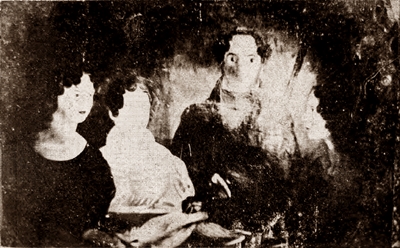
Copy of a photo taken c1858 but
not discovered until 1989, after publication of the NPG catalogue description.
This is the original 'Gun-Group' Portrait with 'Profile Portrait' figure on the far
right.
|
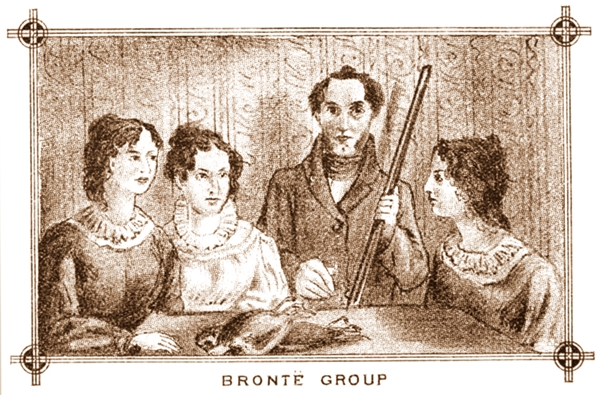
An engraving made from the photo and published in Haworth Past and Present,
1879.
|
|

A photo of the engraving with the
figures identified by Ellen Nussey as L-R:
Emily, Charlotte, Anne.
|
|
|
Arthur Bell Nicholls &
Clement King Shorter
|
|
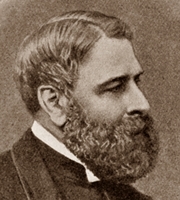
Arthur Bell Nicholls
|
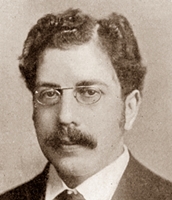
Clement King Shorter
|
The evidence supporting identification of
the 'Profile Portrait' as Emily has always been contradictory. The historian,
Clement Shorter, wrote (1896) that Mr Nicholls (Charlotte Bronte's widower):
“Being of opinion that the only accurate portrait [in the
Gun-Group] was that of Emily, he cut this out and destroyed the
remainder.” 2. The portrait found in Mr Nicholl's house in 1914, eight years after his
death, was the 'Profile Portrait' but this is the figure in the
engraving, identified by Martha Brown (1879) and Ellen Nussey (c1895) as Anne.
Shorter continued: “The portrait of Emily was given to Martha Brown, the servant, on one of
her visits to Mr. Nicholls.” This was
contradicted in 1914 by Mrs Nicholls stating that the painting had never left their
house in Ireland.3.It is also known that whilst Martha Brown did own a portrait
of Emily it was not an oil painting by Branwell but a pencil sketch by
Charlotte.
The Public Image.
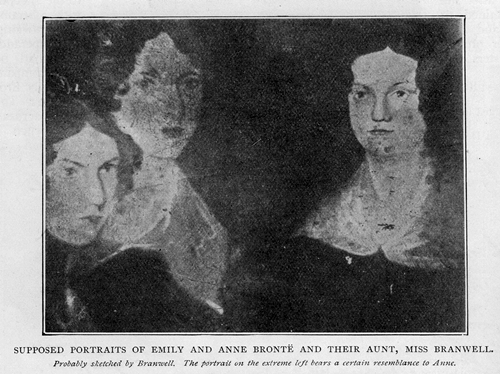
These discrepancies are due in part to a refusal by Mr Nicholls
to acknowledge that any portrait of Charlotte existed other than the idealised 'Richmond
Portrait' (below) which he had authorised for publication in 1857. Shorter wasn’t aware of
this and took him at his word, to a degree. An example of this is when Shorter sent a photo of the
'Pillar Portrait' (above) to Mr Nicholls who replied "The likenesses are very bad - The
left hand corner has something of the expression of Anne - The others I should not
recognise." This is despite the fact that his deceased wife (Charlotte) is on the right.
As a result Shorter published this image in Woman at Home in August 1897, identifying
her as her Aunt Branwell. Shorter had his own idea of what Emily looked like, hence the title in
capitals placing Emily to the left (this is Anne), but including in small italics "the
portrait on the extreme left bears a certain resemblance to Anne" so as not to contradict
Arthur Bell Nicholls.

Shorter made several visits to Mr Nicholls and corresponded with him for over 10
years, the subject of Bronte portraits often arising. During this entire period the original
portraits were languishing in a wardrobe upstairs in Mr Nicholl's house, but he said nothing; his
evasiveness exacerbated Shorter’s confusion.
This was demonstrated again in 1906 in a letter by Shorter to The
Times stating that only one photograph of Mr Nicholls existed when in fact there were at
least six.4. He went on to say that this
"one photo" which was published in his book, was taken at the time of Mr Nicholl’s
marriage to Charlotte in 1854. It was actually taken on his second marriage in 1864.
In 1914, when the 'Profile Portrait' was found in the wardrobe, it was
thought that this was the "portrait of Emily Bronte" seen by William Robertson Nicoll
when he visited Martha Brown in July 1879 and that it had somehow returned to Ireland after
her death in January 1880. The portrait of Emily owned by Martha was though a pencil
portrait by Charlotte and not an oil painting by Branwell.5.
In 1896 Clement Shorter had quoted Arthur Nicholls as saying
that the figure he had cut from the group was Emily. Whether he considered it an
error on his own part, or on that of Arthur Nicholls, by the 1920s he no longer trusted
his own account of their conversation nearly 30 years before. Nor did he have confidence in
Mrs Nicholls identification in 1914.
"the ... portrait of Emily... is really a portrait of Anne."
Ten years later Shorter stated that "the unique and valuable
portrait of Emily... is really a portrait of Anne." He was now convinced that the
National Portrait Gallery had wrongly identified the portrait... although he did not mention that
he was probably partly responsible for this. Clement Shorter died in 1927 and his
account from the 1890s has subsequently been quoted many times but ultimately he believed
it to be incorrect. 6.
|
|
Identification
- Mrs Nicholls
|
|

The 'Profile Portrait'
|
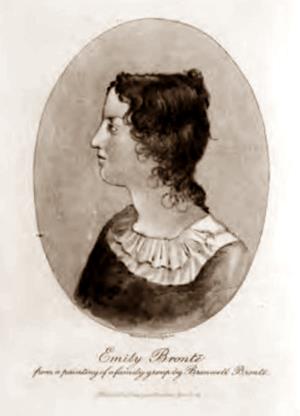
Engraving based on the r/h figure in the
1879 engraving.
|
Arthur Bell Nicholls' first wife was Charlotte Bronte and after her
death in 1855 he remained at Haworth Parsonage until the death of her father, Rev Patrick
Bronte, in 1861. He returned to Ireland and in 1864 married his cousin, Mary Anna
Bell (1830-1915). Mary had met Charlotte a decade earlier, when she was on her honeymoon in
Ireland, but she never met Emily or Anne.
After being hidden away in a wardrobe for 50 years, the 'Profile Portrait' was
'discovered' along with the Pillar Portrait, in 1914. This was eight years the death of
Arthur Nicholls and his Mary Nicholls identified the portrait as Emily. In a
letter to Reginald Smith her niece wrote on her behalf that "the one of Emily [she]
had seen, & remembered Mr Nicholls telling [her] he had cut it out of a painting done by
Branwell as he thought it good but the others were bad, & he told Martha to destroy the
others."
The portraits were not displayed at the house in Ireland so
the identification depends on whether Mrs Nicholls correctly remembered an event on
one day some fifty years earlier. Some historians believed that she had identified the
portrait using what was then the only published portrait of
Emily, an illustration published 14 years earlier. This was an
engraving created by Smith, Elder c1900 on the advice of Clement Shorter based on
the right-hand figure in the 1879 engraving; this had been identified by Martha
Brown and Ellen Nussey as Anne.
In January 1914 Mrs Ellis Chadwick published a book, In the Footsteps
of the Brontes, which included an illustration derived from Martha Brown's photo of
the other group painting, the 'Pillar Portrait.' This was the first time it had been identified as
the portrait described in Elizabeth Gaskell's biography of Charlotte Bronte.

Mrs Nicholls died in 1916 and in 1918 Mrs Chadwick published an
article claiming that the portraits were 'discovered' by Mrs Nicholls because about
December 1913 she had sent her a prospectus for her book which included
this picture of the 'Pillar Portrait'. 7.
|
|
Identification - William
Robertson Nicoll
|
|
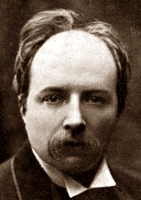
The 'Profile Portrait' is supposed to be the picture of Emily Bronte given
to Martha Brown and seen by William Robertson Nicoll in 1879. This is because in an
article from 1908 he described Martha's portrait of Emily as "a fine and expressive
painting." His two earlier articles he describes it as "a pencil sketch of
Emily by Charlotte." More detail is given on another page: The Lost Portrait of Emily.
|
|
Identification
- The
tracings
|
|
About the time of Clement Shorter's death Charles Simpson began
compiling a biography of Emily Bronte. He had initially thought that the 'Profile
Portrait' was of Emily but after research changed his mind and when published
(1929) the book included a brief chapter advocating that it was of Anne. He
included the photo of the illustration that Clement Shorter had shown to
Charlotte's friend, Ellen Nussey, of the photo of the engraving where she had
identified the figures.

Ellen Nussey identified the sisters L-R:
Emily, Charlotte, Anne.
In 1932, Mabel Edgerley, secretary of the Bronte Society, made the
"fortunate discovery" of three tracings. These tracings were of the figures in
the 'Gun-Group' and supported the identification of the 'Profile Portrait' as Emily. When
these tracings were discovered it was thought that John Greenwood had created them and that he had
labelled them, but he died some 70 years earlier so this was an assumption. We know that Charlotte
and her husband did not want any portraits published so it is unlikely that they let John Greenwood
loose with tracing paper and pencil, especially as he was the village stationer.
|

Tracings either created for or from the
'Gun-Group.'
These are labelled L-R: Anne, Charlotte, Emily.
|
|

Photo of the original 'Gun-Group.'
|
In the tracing of Charlotte her right shoulder is visible, as well as her
left hand. In the photo of the original portrait her shoulder isn't visible and her hand
is below the table. It is likely that the tracings were created
by Branwell and used to position the figures whilst composing the portrait in the
1830s.
|
|
Identification - Martha
Brown
|
|
Martha Brown (the Bronte’s servant) had Branwell's original
'Gun-Group' portrait photographed c1858. Her collodion photo on glass was similar to
a glass negative and a paper print was made from it in 1879; from this print an
engraving was created to illustrate a book, Haworth Past & Present by Joseph
Horsfall Turner. Martha also identified the figures in the
picture.

The engraving as published in Haworth
Past and Present.
"Our picture of the Bronte group
is a faithful reproduction of Mr. Branwell's painting of himself and sisters. I am told the
features of his sisters are represented accurately, but his own are not good. Anne is on Branwell's
left, Charlotte on the right, and Emily to the right of
Charlotte."
This is the published description which doesn't make sense and it
can't be a coincidence that it is describing an image which has been reversed.
Martha Brown will have given her description of the
painting when Horsfall Turner visited and viewed her photo on glass. This was a small, framed
collodion photo and these were normally presented as a reversed image so the description
needs to be read whilst viewing the portrait as Martha Brown would have seen it - reversed.
(see images below).
|

Photograph of the original 'Gun Group'
painting as
printed on paper from Martha Brown's
collodion photo on glass, 1879. The Profile Portrait appears on the right. The engraving was
created from this photo.
|
|

Photograph of the original 'Gun Group'
painting as Martha Brown viewed it -
as a reversed image. Because it is reversed, the 'Profile
Portrait' appears on the left.
"Anne is on Branwell's left, Charlotte on the
right, and Emily to the right of Charlotte."
|
Collodion photos are similar to the
later glass negatives and Martha's was sent to a Bradford photographer in 1879
who printed it (orientation correct) as a carte de visite (small photo on a card mount).
The engraving was made from this cdv to illustrate Horsfall Turner's book
Haworth Past and Present, published in 1879. The description in the book - buried in the text on
another page - wasn't altered to take the reversal into account. For the PDF version of the Horsfall Turner's book click here - the image is between
pages 136-7 & the description is on p.170.
|
|
Identification - Ellen
Nussey
|
|
Copies of the image below had been circulating in
Haworth since the early 1880s and in the 1890s Clement Shorter showed it to
Charlotte’s lifelong friend, Ellen Nussey. She remembered the original painting and
initialled the figures as seen below from left to right as: Emily, Charlotte, Branwell
& Anne.8.

The 'Gun-Group' illustration.
The figures were identified by Charlotte's friend, Ellen Nussey.
The Profile
Portrait relates to the figure on the far right.
Until 1989, this illustration was thought to be a
'drawing' by Branwell and the (1970s) NPG catalogue description states that
Ellen Nussey's labelling of the figures was "probably correct." This is partly because
she remembered the portrait and partly because it makes sense; Emily was the tallest and Anne
the smallest. However, the identification of the figures in this 'Gun-Group
drawing' couldn't be applied to the those in the 'Gun Group painting'
because they were considered to be two unrelated group portraits. Emily and
Anne were not necessarily seated in the same position in both portraits.
In 1989 the photograph (below) of Branwell's
original 'Gun-Group' painting was discovered and it was found that Branwell's
'drawing' was actually an 1870s engraving made from this
photograph. There was no second 'Gun-Group' portrait.

Photo of the original "Gun-Group" portrait
taken c1858 - a copy discovered in
1989.
|
|
Identification - William
Davies
|
|
William Davies visited Rev Patrick Bronte at Haworth Parsonage in 1858 and was
shown the "Gun-Group" portrait.
"On coming away we were shown a painting on the staircase of the sisters
by their brother Branwell. It was crude and harsh from a technical point of view, but the
likenesses were said to be good. The artist himself figured in the picture. He was represented
standing in the middle of the canvas with a gun resting on the ground, dividing the picture by
an awkward line. The details are not very clear to me at this length of time, but I remember
thinking that the portrait of Emily bore a resemblance to the sweet face of the figure looking
out of the picture of Millais' Autumn Leaves.” 8a.
The only figure in the "Gun-Group" definitely not looking out is the one
on right-hand side - the surviving 'Profile portrait.'
John Everett Millais' Autumn Leaves (1856),
Manchester Art Gallery, on Wikipedia
|
|
Comparison using the
tracings & 'Pillar Portrait.'
|
|
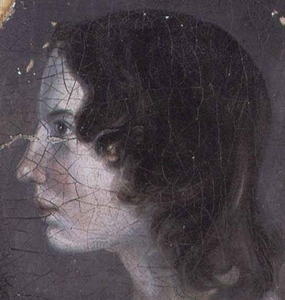
The right-hand tracing represents the
'Profile Portrait' identified as Emily since 1914.
Ellen Nussey stated that “Anne was quite different in appearance from the
others” so it should be possible to differentiate between Emily and
Anne.9. The
tracings below relate to the figures on the left and right of the 'Gun-Group,' one will be
Emily and the other Anne. One sister has a straight nose and the other an aquiline nose.
These are compared here with Emily and Anne in the only surviving group
portrait, known as the 'Pillar Portrait.' From Elizabeth Gaskell’s description of this painting
(1857) we know that the smaller sister is Anne. She has an aquiline nose; this is confirmed by
other portraits of Anne created by Charlotte and one is verified by their father.

|
|
Comparison - Emily &
George Henry Lewes
|
|
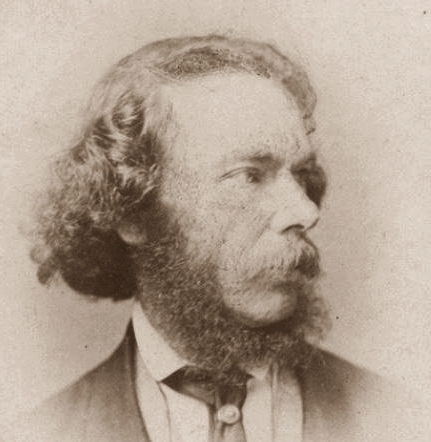
There are no other ‘identified’ portraits of Emily but a strong clue as to
her looks can be found in a letter by Charlotte concerning George Henry Lewes whose
"face almost moves me to tears—it is so wonderfully like Emily—her eyes, her features—the very
nose, the somewhat prominent mouth, the forehead—even at moments the expression." Emily didn't
look like Lewes in this photograph of him as a much older man but we can see that
his nose was not aquiline; it was straight and at a similar angle to Emily's in the 'Pillar
Portrait.' This photograph can also be compared with the 'Pillar Portrait' and the
tracings.10.
|
|
Comparison - Charlotte's
Portrait of Anne
|
|

Charlotte's portrait of her sister Anne.
|

The Profile Portrait - Emily or Anne?
|
Anne was "quite different in appearance from the
others”. Charlotte's portrait of Anne, verified by her father, resembles the sister in
the 'Profile' portrait.
|
|
Conclusion.
|
|
The NPG catalogue description for the Profile Portrait was published in the
1970s. It was thought that there had been three or four group portraits and that
the engraving, with the figures identified by Ellen Nussey, had no connection with the
'Profile Portrait.' Since 1989 it has been known that the photograph of the
original 'Gun-Group,' the tracings, the engraving of the 'Gun-Group' and
the 'Profile Portrait' all relate to Branwell's original 'Gun-Group' and
that there was only one version of it.
In the 1970s the theory was that after the 'Profile
portrait' was taken to Ireland it had returned to England, was in the
possession of Martha Brown in 1879 and then returned to Ireland, ending up in Mr
Nicholls' wardrobe alongside the 'Pillar Portrait.' If William Robertson Nicoll's two earlier
statements (see Lost Portrait of Emily) are correct, the
'Profile Portrait' was not given to Martha Brown and the portrait spent 50 years in the wardrobe
in Ireland. Robertson Nicoll's earlier statements make it clear that Martha possessed a
pencil sketch of Emily by Charlotte, not an oil painting of Emily by Branwell.
When the tracings are compared with the 'photograph of the original
Gun-Group' discovered in 1989 they match the outline of the figures, but
the tracing of Charlotte extends further to her right. It isn't known whether these tracings
predate or postdate the picture but this difference suggests that they were used by
Branwell to compose the portrait in the 1830s and that the labels were added decades
later.
The identification by two of the most reliable sources, Martha Brown and Ellen
Nussey, carry a great deal of weight. Clement Shorter's evidence from the 1890s has been
used to support identification as Emily but ultimately he changed his mind about the portrait,
believing that it depicted Anne. Mrs Nicholls identification depends upon how reliable her
memory was of a fleeting moment on one day, fifty years before.
The visual evidence is more dependable. Branwell has depicted the
right-hand figure as the smallest of the group which suggests that this is Anne. Comparison of
the tracings with Anne and Emily in the 'Pillar Portrait,' to us, makes it clear that the
right-hand tracing is Anne.
The 'Profile Portrait' is treated on this website as a portrait
of Anne; if more evidence comes to light in support of either Emily or Anne it will be added to
this page.
The 'Profile Portrait' at the National Portrait
Gallery
|
|
RETURN TO CONFUSING PORTRAITS INDEX
|
|
Footnotes
|
|
1. The Bronte Portraits: a
Mystery Solved. Juliet R. V. Barker Bronte Society Transactions The Journal of Bronte Studies,
Volume 20, Part 1, 1990 , pp. 3-11
2. Shorter, Clement K:
Charlotte Bronte and Her Circle, ed. 1896, p.123 footnote.
"After Mr. Bronte's death
Mr. Nicholls removed it to Ireland. Being of opinion that the only accurate portrait was that
of Emily, he cut this out and destroyed the remainder. The portrait of Emily was given to
Martha Brown, the servant, on one of her visits to Mr. Nicholls, and I have not been able to
trace it. There are three or four so-called portraits of Emily in existence, but they are all
repudiated by Mr. Nicholls as absolutely unlike her."
3. Mrs Nicholls stated in a
letter to the press (through a close family friend, Rev Sharrard) that the portraits had never left
the house in Ireland, probably after questioning the housemaids:
“Sir, I have received a
copy of the “Morning Post” containing an article animadverting on some information I had
recently forwarded to the King’s County Chronicle with reference to the above. I may state that
your account of the discovery, &c., of the pictures – though not quite correct- was nearer
the truth than any of the accounts I read in other newspapers. The facts are as
follows:
The pictures sent by Mrs.
Nicholls to the National Gallery have been at The Hill House, Banagher, ever since they were
brought there by the late Rev. A. B. Nicholls. The single one of Emily [?] – cut out of a large
portrait containing three sisters – was preserved by Mr. Nicholls. The rest of picture, with
the portraits of his wife Charlotte and Anne [?], was handed to Martha Brown – who lived at The
Hill House for upwards of eight years – not for preservation, but to be destroyed, and it is
believed it was destroyed by her. I need not go into all the reasons for this action on the
part of Mr. Nicholls.
You see, therefore, that I
was correct in saying that the picture of Emily forwarded to the National Gallery was never in
Martha Brown’s possession, though I was mistaken in implying that Mr. Nicholls had ever given
any portrait to Martha Brown. I have the above facts on the best living authority. Yours
&c.
James J. Sherrard., Banagher, March 8, 1914"
Page location
here (PDF - external
website).
4. The Times, Friday 7 December
1906; P.12
5. It was assumed that the
newly discovered 'Profile Portrait' was the same portrait of Emily seen by William Robertson Nicoll
in 1879 but see "Lost Portrait of Emily."
6. Clement Shorter writing in
The Sphere, Saturday 24 May 1924, p.230:
".....Mr Edmund
Gosse...praises the "unique and valuable portrait of Emily," which Mr Drinkwater in his little
book has wrongly titled, for it is really a portrait of Anne. (Here Mr Drinkwater errs, it is
true, with the National Portrait Gallery.) This is quite easy of proof."
Shorter is referring
to the 'Profile Portrait' illustrating the
frontispiece of
John Drinkwater's publication - Branwell Bronte's translation of "The Odes of Quintus Horatius
Flaccus Book 1" published in 1923.
7. THE NINETEENTH CENTURY and
After, A Monthly Review., JULY—DECEMBER 1918. August 1918 "Patrick Branwell Bronte" by Esther Alice
Chadwick. P309-10,
"Although Branwell Brontë
never attained fame as an author or artist, an oil painting of a group of his three sisters by
him hangs in the National Portrait Gallery. I had the honour of discovering that this portrait
was a genuine likeness of the three Bronte sisters by publishing in December 1913 a photograph
taken direct from the painting. On seeing this on the prospectus of my book In the Footsteps of
the Brontës, which was sent to Mrs. A. B. Nicholls (who was the cousin and second wife of
Charlotte Brontë's husband), she recognised it as a copy of the original oil painting which had
been left to her by her husband, after being stowed away in his home at Banagher, Ireland, for
nearly sixty years.
Mrs. Nicholls did not know
it was an actual likeness of the sisters painted by Branwell, and strange to say, Mr. A. B.
Nicholls was also ignorant of the fact, for when a photograph of it was submitted to him by Mr.
Clement Shorter thirty-one years ago he described it as not being genuine. He stated that the
portrait of Charlotte was that of Miss Branwell, and described the one of Emily as unlike her,
although the figure representing Anne he admitted had a slight resemblance to her. Mr. Clement
Shorter, on the authority of Mr. Nicholls, described this as a bogus portrait, in an early
number of The Woman at Home, but I was able to prove that it was genuine by comparing it with
Mrs. Gaskell's minute description published more than sixty years ago.
Mr. George Searle Phillips
also left an account of it in an article published in the Mirror in 1872, and he stated that it
was then in the possession of Charlotte Brontë's husband, which was quite correct. Moreover,
those who knew the Brontës at Haworth were certain of the genuineness, and I interviewed the
daughter of the photographer who took the photograph from the original before Mr. Nicholls
removed it to Ireland in 1861.
Branwell's painting of his
sisters does not hang in the National Portrait Gallery on account of its merit, but because it
is an authentic portrait of the three famous sisters, and contains the only genuine portrait of
Emily, except one in a photograph taken from a carbon drawing by Branwell of the three sisters
and the brother, the original of which has been lost for many years."
8. Simpson, Charles. Emily
Bronte. London: Countrylife, 1929. The illustration of the engraving with figures identified by
Ellen Nussey faces p. 204.
8a. Lemon, Charles. Early
Visitors to Haworth: From Ellen Nussey to Virginia Woolf (Keighley: Brontë Society, 1996),
p.56
9. Reminiscences of Charlotte
Brontë. Ellen Nussey. Scribner's Monthly, an illustrated magazine for the people Volume 2 Issue 1
(May 1871).
10. Letter from Charlotte
Bronte to Ellen Nussey, 12 June 1850.
“I have seen Lewes too—he
is a man with both weaknesses and sins; but unless I err greatly the foundation of his nature
is not bad—and were he almost a fiend in character—I could not feel otherwise to him than half
sadly half tenderly—a queer word the last—but I use it because the aspect of Lewes's face
almost moves me to tears—it is so wonderfully like Emily—her eyes, her features—the very nose,
the somewhat prominent mouth, the forehead—even at moments the expression: whatever Lewes does
or says I believe I cannot hate him.”
|
|
|
|
|

